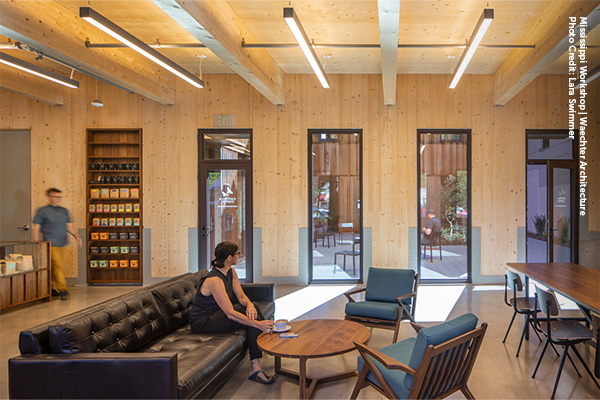HIGHLIGHTS
PROGRAM UPDATES
Faculty Workshops Help to Expand Mass Timber Education Across the Country The AWC’s Wildland-Urban Interface Tests Show Feasibility of Fire-Resistant Wood Construction Partnership With ‘Architectural Record’ Highlights Mass Timber Affordable Housing WoodWorks Launches CLT Diaphragm Design GuideProgram Updates
Faculty Workshops Help to Expand Mass Timber Education Across the Country

A total of 52 faculty from 42 architecture and engineering programs across the United States participated in three SLB-funded faculty workshops, where instructors learned how they could better integrate mass timber education into their own academic programs. The workshops were hosted by the Tallwood Design Institute (TDI), a partnership between University of Oregon and Oregon State; Clemson University’s Wood Utilization + Design Institute; and UMass Amherst in partnership with Leers Weinzapfel Associates (pictured above).
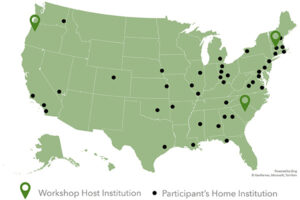
“The Timber Engineering Faculty Development Workshop at Clemson University was not just an event; it was a catalyst for growth, collaboration, and innovation,” said Weichiang Pang, Professor of Engineering at Clemson. “I am confident that these passionate educators will play a pivotal role in advancing wood design education and preparing a new generation of engineers to embrace sustainable and resilient solutions.”
The workshops were led by experts from academia, professional practice, and industry who are at the forefront of wood design and construction. Participants had the opportunity to engage in hands-on activities, tours of facilities, and discussions with industry professionals. The workshops covered topics such as design exercises, fabrication processes, sustainable forest management, and the benefits of mass timber in educational buildings.
The workshops directly addressed the problem of undereducation of wood topics in today’s architecture schools while fostering the exchange of ideas and resources, which will enhance the quality of teaching and research about wood in architecture. The faculty workshops were funded with support from the U.S. Endowment for Forestry and Communities. The SLB is looking to expand the program in 2024.
The AWC’s Wildland-Urban Interface Tests Show Feasibility of Fire-Resistant Wood Construction
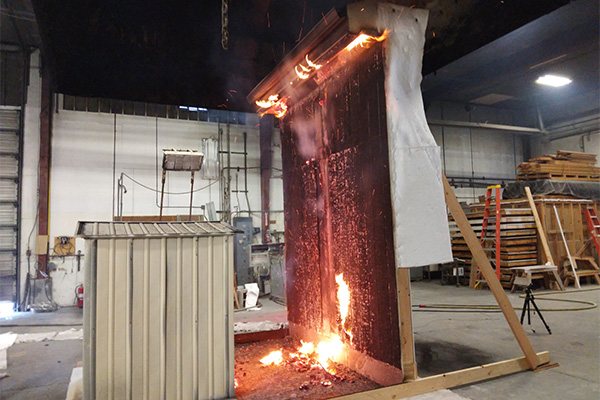
The American Wood Council is proposing a fire-resistance approach to regulate building construction in areas where wildlands meet urban areas, known as the wildland-urban interface, that are more prone to property damage from wildfires. There is growing pressure to ban combustible materials in WUIs, but the AWC is working to demonstrate pathways for the necessary fire resistance to be achieved for light-frame construction to show outright bans are not the only approach in these regions.
The AWC has conducted a fire test to demonstrate the performance of an exterior wood-frame wall assembly and wood-frame eave soffit designed to resist fire penetration into the structure. Test results are still being analyzed, but it is already clear that “hardening” the structure to resist fire entry is possible with adequate fire-resistive construction details.
The AWC plans to complete a second round of tests by the end of the year. The additional testing will help demonstrate that hardening the structure is a feasible solution to limit damage in severe WUI fires. The need for this evidence is particularly pressing in light of the devastating wildfires in Hawaii that have revived collective interest in the fire performance of structures in WUI zones.
Partnership With ‘Architectural Record’ Highlights Mass Timber Affordable Housing
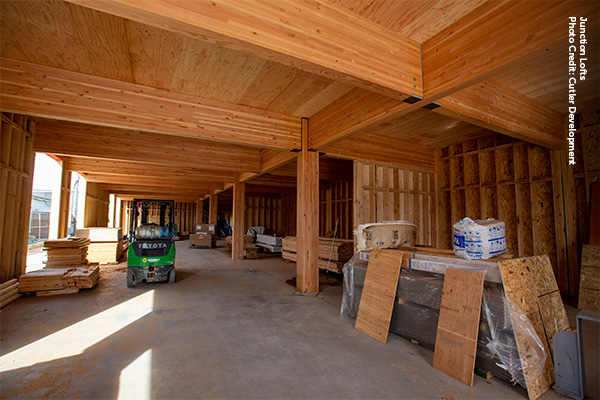
Think Wood recently partnered with Architectural Record to host a continuing education webinar titled Unlocking Mass Timber Affordability. The webinar aimed to educate architects about the cost competitiveness of mass timber—including benefits in other areas of construction that can help make any material premium pencil out—in building more affordable projects.
The event featured panelists with expertise in innovative mass timber projects. Terry Green, Design Principal of W+P | 19six Architects, and Renee Funston, Development Manager of the Capitol Area Development Authority, discussed the Sonrisa affordable housing project in Sacramento, California. Joe Swain from Mithun addressed issues related to the cost of mass timber in the affordable housing sector. And Molly and Scott Cutler, developers from Des Moines, Iowa, discussed their mass timber affordable housing building, Star Lofts, which is seeking Zero Carbon certification. Cutler Development’s Junction Lofts (pictured above) is a three-story mixed-use building that the firm believes is the first mass timber residential structure in Iowa.
Following the webinar, Think Wood implemented a follow-up strategy by sending targeted emails to attendees. These emails included links to relevant Think Wood resources, such as interviews with the panelists and reports on the benefits and affordability of mass timber schools. The goal was to further educate architects about incorporating cost-effective wood products into their construction projects.
The webinar will also be available on demand for the next year, allowing for ongoing engagement and the opportunity to bring in new contacts and leads.
WoodWorks Launches CLT Diaphragm Design Guide
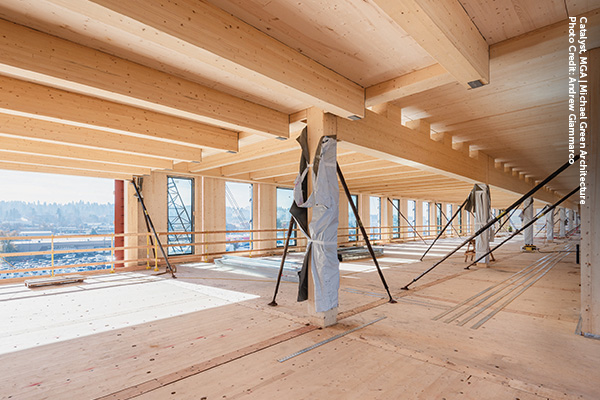
WoodWorks has released a new guide for the design of cross-laminated timber diaphragms, which are horizontal panels that transfer wind and seismic loads to the vertical force-resisting system in a building.
While CLT floor panels are commonly used in mass timber buildings, their use as a diaphragm has been limited. This has led building designers to use other materials or seek special approval for their use. However, as building codes and standards evolve to address CLT more comprehensively, the AWC standard, Special Design Provisions for Wind and Seismic (SDPWS), now includes new CLT diaphragm design provisions.
WoodWorks’ CLT Diaphragm Design Guide provides insight into the analysis, design, and constructability of CLT diaphragms that follow these provisions. It will help practicing engineers become more comfortable selecting CLT for these applications in mass timber projects, and it can play an important role in growing market share and expanding the use of CLT across the country.
Spotlight
Amazon Turns to Mass Timber and Biophilic Design to Attract Employees to Its New Headquarters
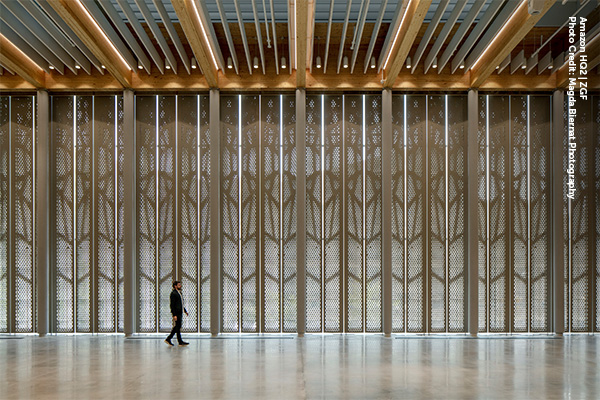
Retail juggernaut Amazon’s recent completion of phase one of its second headquarters, in Arlington, Virginia, and its use of mass timber construction for the office’s meeting center, is compelling proof that mass timber is going mainstream as more and more corporations look to deliver sustainable, biophilic workplaces for their employees.
The project includes an enormous multipurpose meeting room featuring a mass timber ceiling made from 70-foot-long glulam beams. In a GreenBiz profile, Brian Earle, ZGF’s lead architect for the project, said mass timber was selected for both its sustainable low-carbon benefits and its ability to provide a warm, inviting environment for its workers—and to serve as a case study for future projects.
“By using structural timber, we saw an opportunity to expand industry knowledge of the material in the region,” he says, “paving the way for its broader adoption in the future.” Along with its use of mass timber, the new facility has earned a LEED Platinum certification thanks to a long list of credentials that include renewable energy, water recycling, and waste reduction.
Amazon estimates a 20% reduction in the carbon footprint of the headquarters’ structures compared with the industry baseline, saving over 14,700 metric tons of carbon, or the equivalent of taking more than 3,200 cars off the road for an entire year.
These sustainable design choices and construction features allowed Amazon to construct a larger building on the lot than is typical because of Arlington’s Green Building Incentive Program, which rewards developers for making greener choices with increased capacity for construction.
Amazon second headquarters joins a growing list of workplaces using biophilic design and mass timber, which includes the Houston Endowment Headquarters, 80 M Street, Google’s Spruce Goose, Washington Fruit & Produce Company, and more.
And you can check out more of ZGF’s wood and mass timber design innovations in Think Wood’s Studio Spotlight.
Industry Resources
FEA’s Housing Dashboard
Virginia Tech's Monthly Housing Report
This monthly housing commentary report is a free service of Virginia Tech and is intended to help one gauge future business activity in the U.S. housing market.
June 2023 Reports (released in August 2023)
Part A: June Housing Commentary
Part B: June Economic Conditions


